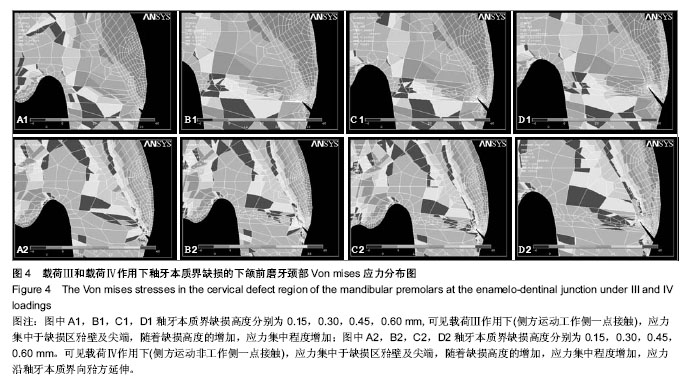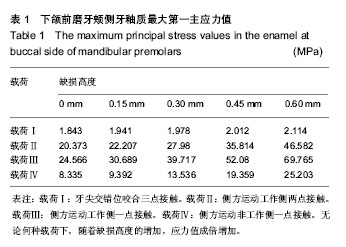| [1] 张清,王嘉德,李萍,等.中老年人牙齿楔状缺损相关因素的logistic回归分析[J].中华流行病学杂志,2001,22(1):43-45.
[2] Kassab MM, Cohen RE.The etiology and prevalence of gingival recession.J Am Dent Assoc. 2003;134(2): 220-225.
[3] Zucchelli G, Gori G, Mele M, et al.Non-carious cervical lesions associated with gingival recessions: a decision-making process.J Periodontol. 2011;82(12):1713-1724.
[4] Rotundo R, Mori M, Bonaccini D, et al.Intra- and inter-rater agreement of a new classification system of gingival recession defects.Eur J Oral Implantol. 2011;4(2):127-133.
[5] Grippo JO, Simring M, Coleman TA.Abfraction, abrasion, biocorrosion, and the enigma of noncarious cervical lesions: a 20-year perspective.J Esthet Restor Dent. 2012;24(1):10-23.
[6] Palomino-Gómez SP, Jeremias F, Finoti LS, et al. Influence of lateral excursion on vestibular cervical dental abfraction.Acta Odontol Latinoam. 2011;24(3):283-288.
[7] Hur B, Kim HC, Park JK, et al.Characteristics of non-carious cervical lesions--an ex vivo study using micro computed tomography.J Oral Rehabil. 2011;38(6):469-474.
[8] Senna P, Del Bel Cury A, Rösing C.Non-carious cervical lesions and occlusion: a systematic review of clinical studies.J Oral Rehabil. 2012;39(6):450-462.
[9] Jiang H, Du MQ, Huang W, et al.The prevalence of and risk factors for non-carious cervical lesions in adults in Hubei Province, China.Community Dent Health.2011;28(1):22-28.
[10] Srirekha A, Bashetty K.A comparative analysis of restorative materials used in abfraction lesions in tooth with and without occlusal restoration: Three-dimensional finite element analysis.J Conserv Dent. 2013;16(2):157-161.
[11] Francisconi LF, Graeff MS, Martins Lde M, et al.The effects of occlusal loading on the margins of cervical restorations.J Am Dent Assoc. 2009;140(10):1275-1282.
[12] Takehara J, Takano T, Akhter R, et al.Correlations of noncarious cervical lesions and occlusal factors determined by using pressure-detecting sheet.J Dent. 2008;36(10): 774-779.
[13] Brandini DA, Pedrini D, Panzarini SR, et al.Clinical evaluation of the association of noncarious cervical lesions, parafunctional habits, and TMD diagnosis.Quintessence Int. 2012;43(3):255-262.
[14] Tiossi R, Vasco MA, Lin L, et al.Validation of finite element models for strain analysis of implant-supported prostheses using digital image correlation.Dent Mater. 2013;29(7): 788-796.
[15] Akca K, Eser A, Eckert S, et al.Immediate versus conventional loading of implant-supported maxillary overdentures: a finite element stress analysis.Int J Oral Maxillofac Implants. 2013;28(2):e57-63.
[16] Chang CL, Chen CS, Huang CH, et al.Finite element analysis of the dental implant using a topology optimization method.Med Eng Phys. 2012;34(7):999-1008.
[17] Saidin S, Abdul Kadir MR, Sulaiman E, et al.Effects of different implant-abutment connections on micromotion and stress distribution: prediction of microgap formation.J Dent. 2012;40(6):467-474.
[18] Ormianer Z, Palti A, Demiralp B, et al.Implant-supported first molar restorations: correlation of finite element analysis with clinical outcomes.Int J Oral Maxillofac Implants. 2012;27(1): e1-12.
[19] Ormianer Z, Ben Amar A, Duda M, et al. Stress and strain patterns of 1-piece and 2-piece implant systems in bone: a 3-dimensional finite element analysis.Implant Dent. 2012; 21(1):39-45.
[20] Wang Hui-yun. Measurement and Statistics of tooth in Chinese people. Chin J Stomatol. 1959;7(3):149-155.
[21] Lindhe J, Karring T, Araujo M. Anatomy of the periodontium. In: Lindhe J, Karring T, Lang NP, eds. Clinical periodontology and implant dentistry. 4th ed. Denmark: Blackwell Munksgaard, 2003:27-43.
[22] Rees JS, Hammadeh M.Undermining of enamel as a mechanism of abfraction lesion formation: a finite element study.Eur J Oral Sci. 2004;112(4):347-352.
[23] Rees JS, Jacobsen PH.Modelling the effects of enamel anisotropy with the finite element method.J Oral Rehabil. 1995;22(6):451-454.
[24] Rees JS, Jacobsen PH.Elastic modulus of the periodontal ligament.Biomaterials. 1997;18(14):995-999.
[25] Romeed SA, Malik R, Dunne SM.Stress analysis of occlusal forces in canine teeth and their role in the development of non-carious cervical lesions: abfraction.Int J Dent. 2012; 2012:234845.
[26] Borcic J, Anic I, Smojver I, et al.3D finite element model and cervical lesion formation in normal occlusion and in malocclusion.J Oral Rehabil. 2005;32(7):504-510.
[27] Dejak B, M?otkowski A, Langot C.Three-dimensional finite element analysis of molars with thin-walled prosthetic crowns made of various materials.Dent Mater. 2012;28(4):433-441.
[28] Rodrigues FP, Silikas N, Watts DC, et al. Finite element analysis of bonded model Class I 'restorations' after shrinkage.Dent Mater. 2012;28(2):123-132.
[29] Benazzi S, Kullmer O, Grosse IR, et al. Using occlusal wear information and finite element analysis to investigate stress distributions in human molars.J Anat.2011;219(3): 259-272.
[30] De Las Casas EB, Cornacchia TP, Gouvêa PH, et al. Abfraction and anisotropy--effects of prism orientation on stress distribution.Comput Methods Biomech Biomed Engin. 2003;6(1):65-73.
[31] Ma H, Wang Q, Liu Z, et al.The influence of lateral occlusal forces to the stress distribution of restorative material of wedge-shaped defect.Hua Xi Kou Qiang Yi Xue Za Zhi. 2011; 29(5):550-554.
[32] 夏荣明,吴小斌.不同深度楔状缺损的应力分析[J]. 口腔医学研究, 2005,21(4):443-444.
[33] Kuroe T, Caputo AA, Ohata N, et al.Biomechanical effects of cervical lesions and restoration on periodontally compromised teeth.Quintessence Int. 2001;32(2):111-118.
[34] Dejak B, Mlotkowski A, Romanowicz M.Finite element analysis of mechanism of cervical lesion formation in simulated molars during mastication and parafunction.J Prosthet Dent. 2005;94(6):520-529.
[35] Pegoraro LF, Scolaro JM, Conti PC, et al.Noncarious cervical lesions in adults: prevalence and occlusal aspects.J Am Dent Assoc. 2005;136(12):1694-1700.
[36] Pecie R, Krejic I, Garcia-Godoy F, et al.Noncarious cervical lesions--a clinical concept based on the literature review. Part 1: prevention.Am J Dent. 2011;24(1):49-56.
[37] Madani AO, Ahmadian-Yazdi A. An investigation into the relationship between noncarious cervical lesions and premature contacts.Cranio. 2005;23(1):10-15.
[38] Bernhardt O, Gesch D, Schwahn C, et al.Epidemiological evaluation of the multifactorial aetiology of abfractions.J Oral Rehabil. 2006;33(1):17-25.
[39] Fron H, Vergnes JN, Moussally C, et al. Effectiveness of a new one-step self-etch adhesive in the restoration of non-carious cervical lesions: 2-year results of a randomized controlled practice-based study.Dent Mater. 2011;27(3): 304-312. |





